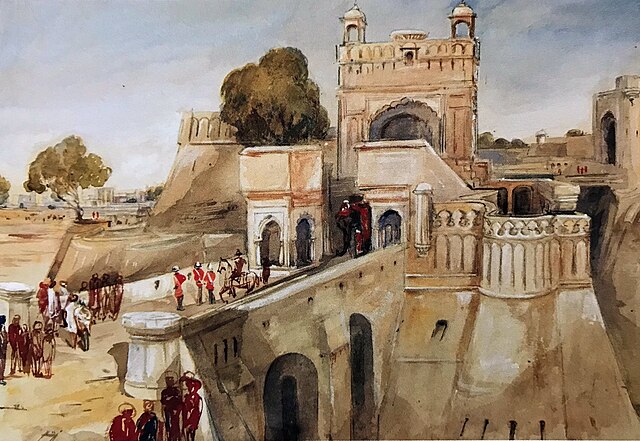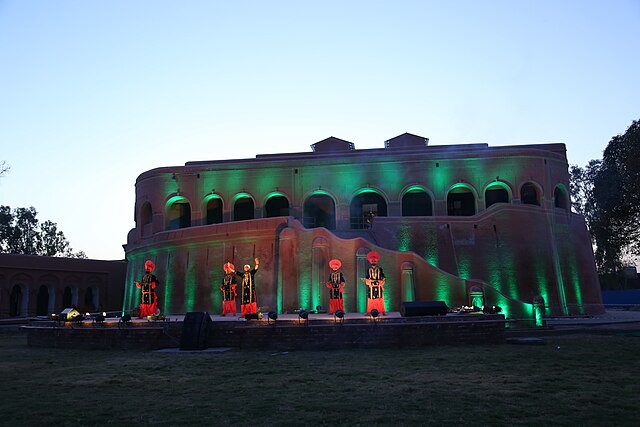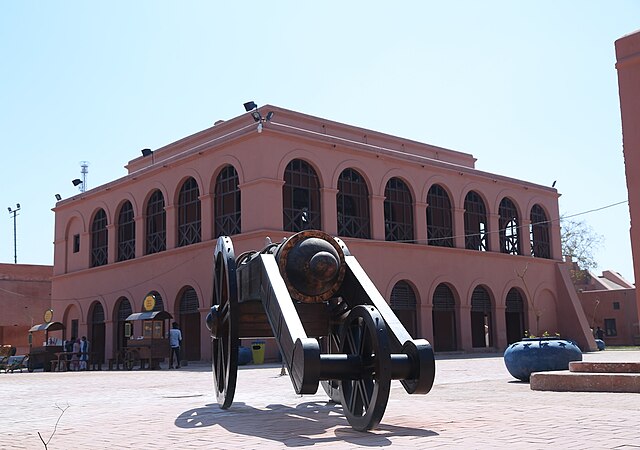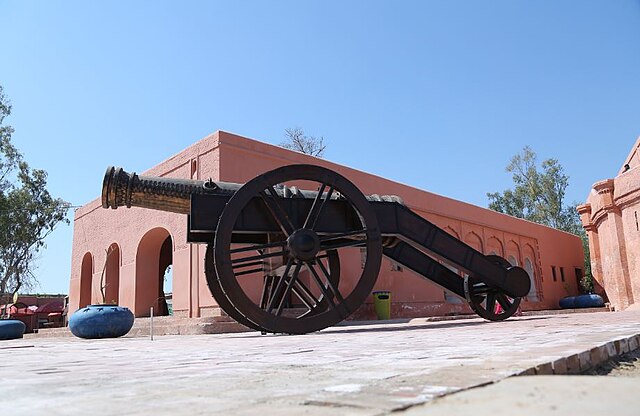Have you ever wondered what stories ancient walls could tell if they could speak? Gobindgarh Fort in Amritsar stands as one of Punjab’s most fascinating historical monuments, yet it remains surprisingly underexplored by many travelers. This magnificent fortress, which has witnessed centuries of Punjab’s tumultuous history, offers visitors an incredible journey through time.
Located in the heart of Amritsar, just a stone’s throw away from the famous Golden Temple, Gobindgarh Fort represents the perfect blend of historical significance and modern presentation. Unlike many historical sites that feel distant and disconnected from contemporary life, this fort has been beautifully restored to offer an immersive experience that brings history to life.
What makes Gobindgarh Fort truly special isn’t just its impressive architecture or strategic importance – it’s the way it encapsulates the spirit of Punjab itself. From its origins as a military stronghold to its current status as a cultural hub, this fort tells the story of a region that has been shaped by warriors, saints, and visionaries.
The Historical Significance of Gobindgarh Fort
Origins and Early Construction
The story of Gobindgarh Fort begins in the 18th century, during one of the most turbulent periods in Punjab’s history. Originally constructed around 1760, the fort’s strategic location wasn’t chosen by accident. Positioned at the crossroads of major trade routes, it served as a crucial military outpost that could control movement across the region.
The fort’s name itself carries deep significance. “Gobindgarh” translates to “Fort of Gobind,” paying homage to Guru Gobind Singh, the tenth Sikh Guru who played a pivotal role in shaping Sikh identity and military traditions. This naming reflects the fort’s connection to Sikh heritage from its very inception.
During its early years, the fort changed hands multiple times as various local rulers and military leaders recognized its strategic value. Each occupant left their mark on the structure, contributing to the complex architectural layers that visitors can observe today.
The Sikh Empire Era
The fort’s golden age arrived with the rise of the Sikh Empire under Maharaja Ranjit Singh in the early 19th century. Known as the “Lion of Punjab,” Ranjit Singh transformed Gobindgarh Fort into one of the most important military installations in his vast empire.
Under Sikh rule, the fort became much more than just a military outpost. It served as a treasury, storing the wealth of the empire, including the famous Koh-i-Noor diamond before it was eventually lost to the British. The fort’s underground chambers and secret passages, many of which can still be explored today, were designed to protect these invaluable treasures.
Maharaja Ranjit Singh’s vision extended beyond mere military utility. He understood that the fort needed to represent the power and grandeur of the Sikh Empire. Extensive renovations during this period added elegant residential quarters, audience halls, and ceremonial spaces that reflected the sophistication of Sikh court culture.
British Colonial Period
The annexation of Punjab by the British in 1849 marked a significant turning point in Gobindgarh Fort’s history. The British, recognizing the fort’s strategic importance and symbolic value, maintained it as a military installation while adapting it to their administrative needs.
During the colonial period, the fort served various functions – from military barracks to administrative offices. The British also used it as a prison for political prisoners, including several freedom fighters who opposed colonial rule. This period added another layer to the fort’s complex history, making it a symbol of both oppression and resistance.
Interestingly, the British made several structural modifications to the fort, adding elements that reflected their architectural preferences while maintaining the basic Sikh-era layout. These modifications create an interesting architectural dialogue between different periods and cultures.
Architectural Marvel: Understanding the Fort’s Design

Strategic Military Architecture
Walking through Gobindgarh Fort today, you can’t help but admire the military genius behind its design. Every element of the fort’s architecture serves a defensive purpose, from the massive outer walls to the strategic placement of watchtowers.
The fort follows the classic star-shaped design that was popular in military architecture during the 18th and 19th centuries. This design maximized defensive capabilities by eliminating blind spots and allowing defenders to provide covering fire from multiple angles. The walls, built with a combination of brick and stone, are thick enough to withstand cannon fire while providing stable platforms for the fort’s own artillery.
One of the most impressive features is the fort’s water management system. Ancient engineers designed an intricate network of channels and reservoirs that ensured a steady water supply even during extended sieges. This system demonstrates the sophisticated understanding of hydraulic engineering that existed in Punjab centuries ago.
Unique Structural Features
The Massive Walls and Bastions
The fort’s walls are perhaps its most striking feature. Rising majestically from the ground, these walls create an imposing silhouette that has dominated Amritsar’s skyline for centuries. Built with locally sourced materials, the walls showcase traditional Punjabi construction techniques adapted for military purposes.
The bastions, or defensive projections from the main walls, are positioned at strategic intervals to provide comprehensive coverage of the fort’s perimeter. Each bastion was designed to house artillery pieces and provide accommodation for the soldiers who manned them. Today, these bastions offer visitors spectacular views of Amritsar and serve as excellent photography spots.
What’s particularly fascinating is how the architects managed to balance defensive requirements with aesthetic considerations. The walls aren’t just functional – they’re beautiful, with decorative elements that reflect the artistic sensibilities of their creators.
Interior Layout and Chambers
Step inside Gobindgarh Fort, and you’ll discover a complex network of chambers, courtyards, and passages that reveal the sophisticated planning behind its construction. The interior layout reflects the fort’s multiple functions – military, residential, administrative, and ceremonial.
The main courtyard serves as the heart of the fort, surrounded by various structures that housed different functions. The commanding officer’s residence, with its elegant architecture and strategic positioning, demonstrates how military leadership was expected to live. The soldiers’ quarters, while more modest, were designed with consideration for comfort and functionality.
Perhaps most intriguing are the underground chambers and secret passages that honeycomb the fort’s foundation. These spaces served multiple purposes – storage for treasure and supplies, escape routes during emergencies, and secure meeting places for sensitive discussions. Exploring these areas today gives visitors a thrilling sense of discovery and adventure.
Cultural Heritage and Museums

The Sikh Museum Experience
Gobindgarh Fort has been transformed into a world-class cultural destination, and the Sikh Museum represents the crown jewel of this transformation. This museum doesn’t just display artifacts – it creates an immersive experience that brings Sikh history and culture to life.
The museum’s exhibits are arranged chronologically, taking visitors on a journey from the founding of Sikhism by Guru Nanak to the modern era. Interactive displays, multimedia presentations, and carefully curated artifacts help visitors understand the evolution of Sikh culture, philosophy, and military traditions.
What sets this museum apart is its focus on storytelling. Rather than simply presenting objects in glass cases, the exhibits weave narratives that help visitors understand the context and significance of what they’re seeing. The museum explores themes like the Sikh concept of seva (selfless service), the importance of the Guru Granth Sahib, and the evolution of Sikh military traditions.
Coin Museum and Numismatic Collection
For those interested in economic history and numismatics, the fort’s Coin Museum offers a fascinating glimpse into Punjab’s monetary heritage. The collection includes coins from various periods of the region’s history, providing insights into trade, politics, and cultural exchange.
The museum’s highlight is its collection of coins from the Sikh Empire period, including rare specimens that bear the inscriptions and symbols of Maharaja Ranjit Singh’s reign. These coins tell stories about the empire’s economic policies, artistic preferences, and political relationships with neighboring powers.
The presentation of the numismatic collection is particularly well done, with detailed explanations of each coin’s historical context and significance. Interactive displays help visitors understand how currency reflects broader historical trends and cultural values.
Tourist Attractions and Activities

Light and Sound Shows
One of the most popular attractions at Gobindgarh Fort is the spectacular light and sound show that takes place every evening. This multimedia presentation uses the fort’s walls as a canvas to tell the story of Punjab’s history, from ancient times to the present day.
The show combines cutting-edge projection technology with carefully crafted narration and music to create an emotional and educational experience. As lights dance across the ancient walls, visitors are transported through centuries of history, witnessing the rise and fall of empires, the birth of Sikhism, and the struggles of the independence movement.
What makes this show particularly effective is its ability to make history feel immediate and relevant. Rather than presenting dry facts and dates, the show focuses on human stories and emotions, helping visitors connect with the past on a personal level.
Interactive Experiences
Modern visitors expect more than passive observation, and Gobindgarh Fort delivers with a range of interactive experiences designed to engage all the senses. Virtual reality stations allow visitors to experience historical events from the perspective of people who lived through them.
The fort also offers traditional craft demonstrations where visitors can observe and participate in activities like traditional Punjabi cooking, handicraft making, and folk music performances. These experiences provide insights into the daily life and cultural traditions of historical Punjab.
For families with children, the fort includes special interactive zones designed to make history fun and accessible. Treasure hunts, costume experiences, and hands-on archaeological activities help young visitors develop an appreciation for history while having fun.
Visiting Gobindgarh Fort: Practical Information

Best Times to Visit
Planning your visit to Gobindgarh Fort requires some consideration of weather and crowd patterns. The best months to visit are October through March, when Punjab’s weather is most pleasant. During these months, you can comfortably explore the fort’s outdoor areas and fully enjoy the evening light and sound shows.
Winter months (December to February) offer the most comfortable temperatures, but they’re also the busiest tourist season. If you prefer fewer crowds, consider visiting during the shoulder seasons of October-November or February-March.
The fort is open throughout the year, but summer months (April through September) can be extremely hot, making outdoor exploration less comfortable. However, many of the indoor attractions, including the museums, are climate-controlled and can be enjoyed year-round.
Entry Fees and Timings
Gobindgarh Fort operates with reasonable entry fees that make it accessible to a wide range of visitors. The basic entry ticket includes access to the fort premises and the main museum, while additional fees apply for special experiences like the light and sound show.
The fort typically opens at 10:00 AM and closes at 10:00 PM, allowing for both daytime exploration and evening entertainment. The light and sound shows usually begin around sunset, with multiple shows during peak season to accommodate demand.
For the best experience, plan to spend at least half a day at the fort. This allows time to explore the various attractions, enjoy the museums, and participate in interactive experiences without feeling rushed.
Conclusion: Why Gobindgarh Fort Deserves Your Visit
Gobindgarh Fort represents something rare in today’s world – a historical site that successfully bridges the gap between past and present. While maintaining its historical authenticity and architectural integrity, the fort has embraced modern presentation techniques to create an experience that educates, entertains, and inspires.
For history enthusiasts, the fort offers deep insights into Punjab’s complex past and the evolution of Sikh culture. For families, it provides an engaging and educational day out that will create lasting memories. For anyone interested in architecture and military history, the fort’s design and strategic importance offer fascinating case studies.
What truly sets Gobindgarh Fort apart is its ability to make history feel alive and relevant. In an age when many historical sites feel like dusty museums, this fort pulses with energy and meaning. It reminds us that history isn’t just about the past – it’s about understanding how the past continues to shape our present and future.
Whether you’re a seasoned traveler, a history buff, or someone simply looking for a unique experience in Amritsar, Gobindgarh Fort should definitely be on your itinerary. It offers the perfect complement to a visit to the Golden Temple, providing deeper context for understanding Punjab’s rich cultural heritage.
Frequently Asked Questions (FAQs)
1. How long does it take to fully explore Gobindgarh Fort?
A comprehensive visit to Gobindgarh Fort typically takes 4-6 hours, including time for the museums, interactive experiences, and the light and sound show. If you’re particularly interested in history or want to participate in all available activities, plan for a full day visit.
2. Is Gobindgarh Fort suitable for children and elderly visitors?
Yes, the fort is designed to be accessible to visitors of all ages. The pathways are well-maintained, and there are plenty of seating areas throughout the complex. Special interactive zones cater specifically to children, while the comprehensive historical exhibits appeal to adult visitors.
3. Can I visit Gobindgarh Fort and the Golden Temple on the same day?
Absolutely! The fort is located very close to the Golden Temple, making it easy to visit both in a single day. Many visitors start with the Golden Temple in the morning and spend the afternoon and evening at Gobindgarh Fort, ending with the spectacular light and sound show.
4. Are there dining options available at Gobindgarh Fort?
Yes, the fort complex includes several dining options ranging from traditional Punjabi cuisine to international fare. There are also cafeterias and snack bars scattered throughout the premises, so you won’t need to leave the fort for meals during your visit.
5. Is photography allowed inside Gobindgarh Fort?
Photography is generally permitted in most areas of the fort, including the courtyards and exterior spaces. However, some museum exhibits may have restrictions on flash photography or photography altogether. It’s best to check with staff at each location and respect any posted guidelines to help preserve the artifacts and exhibits.

